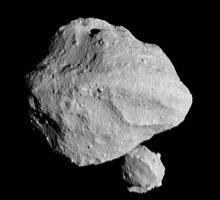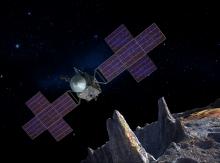Listen to today's episode of StarDate on the web the same day it airs in high-quality streaming audio without any extra ads or announcements. Choose a $8 one-month pass, or listen every day for a year for just $30.
You are here
Asteroids
A century ago, astronomers had cataloged a thousand asteroids — chunks of rock, metal, and ice that orbit the Sun. Today, they’ve cataloged more than a million. And the numbers are growing fast.
There are a couple of reasons for the bonanza. One is improved technology — modern instruments can detect objects that are smaller and fainter than ever before. And the other is that astronomers are putting more effort into looking for asteroids.
Most asteroids are found in a wide belt between Mars and Jupiter. They’re left over from the formation of the solar system. Jupiter’s gravity prevented them from coalescing to form a planet. The largest member of the belt, Ceres, is only about 600 miles across — roughly a quarter the size of the Moon.
As long as asteroids stay in the belt, they’re fine. Sometimes, though, an asteroid escapes the belt. It can move into our region of the solar system, where it could hit us, causing a global catastrophe.
And that’s why there’s so much effort to find asteroids. Plotting their orbits tells us whether they might threaten Earth. With enough lead time, we might be able to deflect a potential killer.
So astronomers are operating several automated searches. Telescopes photograph the skies every night, looking for objects that move against the background of stars. That reveals asteroids close to Earth. But it also reveals asteroids throughout the solar system — adding to the census of these cosmic rocks.
Script by Damond Benningfield






